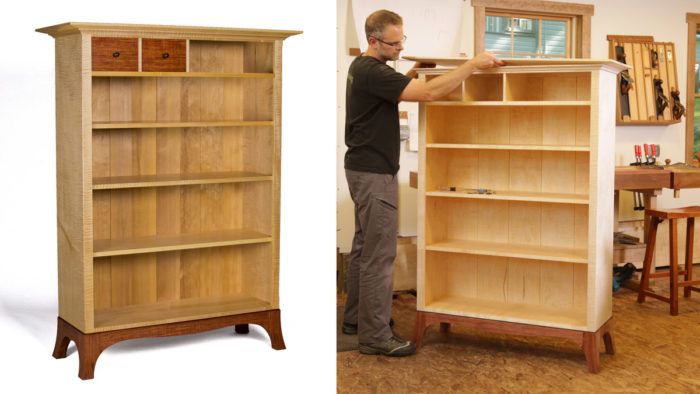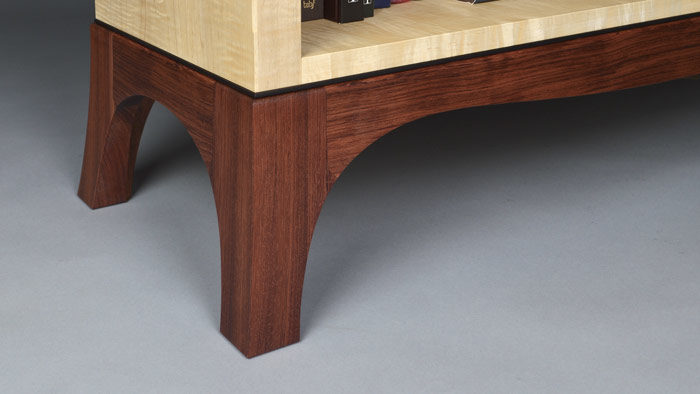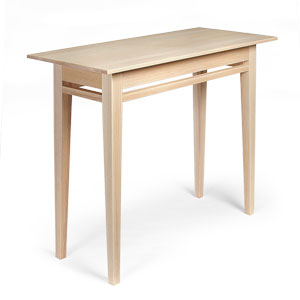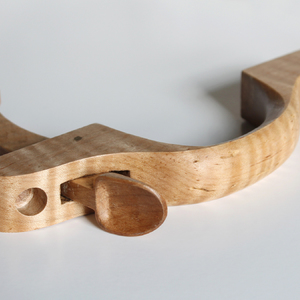Elegant Bookcase, Top to Bottom
A profiled top and splayed base add style to this piece, and the aprons and feet pack a lot of curves into a small space.
If you read and appreciate books, as I do, then you probably appreciate the functional aspects of a bookcase. If you enjoy beautiful materials and elegant, understated design, as I do, then I hope the design of this piece will appeal to you as well. I built it with a matched set of curly maple boards, which I purchased from Irion Lumber. I paired the maple with sexy, straight-grained bubinga for the base. And I used East Indian rosewood as an accent.
There is a lot of exacting joinery in the carcase, which has sliding dovetails joining the shelves to the sides and half-blind dovetails joining the sides to the bottom. That’s all spelled out in the drawing. But for this article I’ve chosen to focus on the base and the top molding. These two components might not be the first things to catch your eye, but they are vital to the look of the piece, and they are both a bit more challenging than they might seem.

The feet on this base pack a lot of curves and unusual joinery into a small space. I begin making them by cutting the angled kerf for the gunstock miters. These little miters add a bit of refinement to the design, and also eliminate short grain that might be prone to breaking off. I cut them with a miter gauge on the tablesaw. I cut the mating miters on the aprons now as well.
With those cut, I mortise the feet and aprons to accept slip tenons. I do this with a plunge router and a 3⁄8-in. upcutting end mill bit. I built a jig for the router that makes the mortising go quite smoothly.
The feet flare outward, making the feet and aprons slightly concave on their outer faces. To create that flare, I make a curved template and trace it onto the feet. Then I use the bandsaw to cut the profile. I’ll remove some of the bandsaw marks at this point with hand tools, but I wait until the base is fully assembled to finish the cleanup.
Next I cut the miters where the two halves of each foot are joined. I rip these miters on the tablesaw, with the blade set at 45°. Then, without changing the sawblade angle, I move the fence to the opposite side of the blade and cut spline grooves in the mitered faces.
For the full article, download the PDF below:
More on FineWoodworking.com
- Designer’s Notebook: Mike Korsak’s En Pointe
- Video – Behind The Design: Mike Korsak’s En Pointe
- Video – Taming Tough Grain with a Bevel-Up Plane

Get the Plan
Bookcase with Drawers
Careful wood choices enhance the design of this bookcase by Mike Korsak. He chose to pair beautifully figured maple with a bubinga base; your wood choices should be just as careful because even loaded with books, there is a lot of wood visible in this piece. The shelves are joined to the sides with sliding dovetails, and half-blind dovetails join the sides to the bottom. The aprons and feet are curved, and the feet pack a lot of curves and challenging joinery such as gunstock miters into a small space. A cove molding adds a final bit of elegance to the top.






















Comments
I found the foot of this bookcase to be very hard to get square. I have to wonder why the feet weren't just built from one piece that was shaped? Why all the miter cuts on curved pieces? I scraped the first try and did it just that way. It looks the same, only much simpler.
Log in or create an account to post a comment.
Sign up Log in